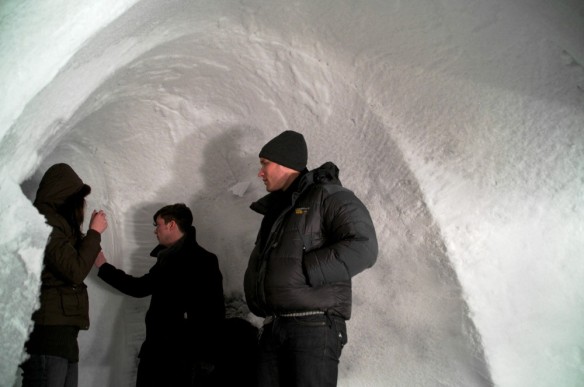We are heading back to the Harvard to check out a temporary structure designed by Carl Koepcke, Marshall Prado. This takes building an igloo to the next level, instead of shoveling together heavy blocks of snow, these GSD students used a little parametric modeling, some digital fabrication, and a lot of ingenuity to design and construct this project. Nine hours of construction and 92 unique panels of 3 mil plastic sheeting and some double-sided polyester tape and you check out what happen next after the jump!
SCHOOL: Harvard Graduate School of Design
STUDENTS: Carl Koepcke, Marshall Prado
PROFESSORS: David Mah
YEAR: 2012
“Under the guidance of David Mah, Carl Koepcke and Marshall Prado from Harvard Graduate School of Design created a system for constructing a rapidly deployable ice shelter using snow and ice as building materials. The temporary shelter is intended for cold environments and utilizes the insulative properties and inherent compressive strength of the proposed building materials to craft a spatial catenary volume.
Using parametric modeling and digital fabrication techniques, plastic panels define the framework for the shelter and are joined to make the inflatable structure. Such panels supply a lightweight and packable guideline for the shelter, allowing users to carry the system in a large backpack until construction is necessary. “Instead of using traditional igloo construction, the proposed process could be self-forming under wet, frozen conditions,” explained the designers.
The self-supporting thinwalled shelter builds upon earlier research on pneumatic structures as form-finding and space-making devices. The final product has sectional variability within the catenary structure to optimize multiple interior and exterior spaces. This form utilized internal air pressure and catenary diaphragms define and control the desired inflated shape.
“While fabric reinforcement was used to strengthen and connect the catenary ribs, it was discovered that an ice shell of approximately ½” was capable of supporting itself without further bracing,” explained the designers.
Check out the time-lapse illustrating the assembly process with regards to how the 92 unique milled plastic panels were arranged and joined together for construction using double sided polyester tape and some packing tape for extra reinforcing.”
Inflatable Assembly from Carl Koepcke on Vimeo.
All Images via Koepcke + Prado
All Text via http://www.archdaily.com











